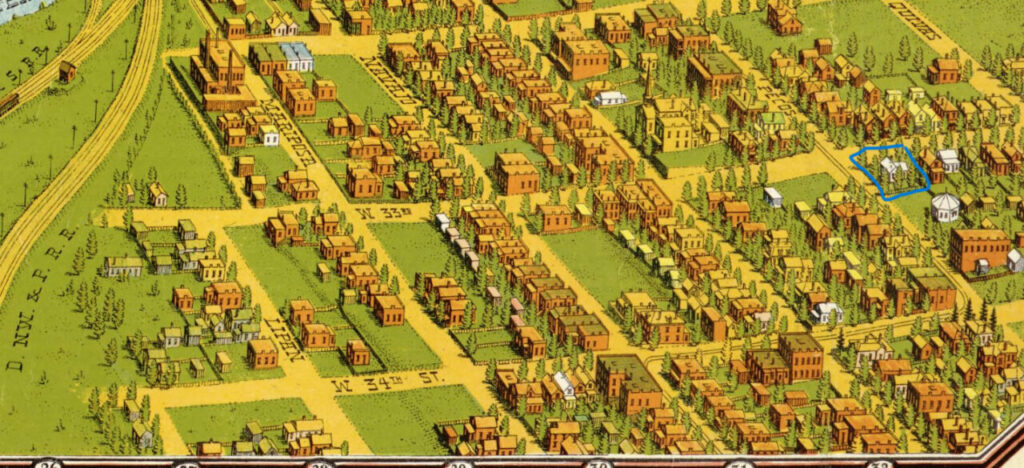The print version of this column, originally published Jan. 15, 2023, was updated Dec. 15, 2023 for clarity based on information provided by readers.
By Rebecca A. Hunt
From its beginnings, the Northside has been a center of ethnic diversity. Last month I told you the story of the Irish. Now I will spend some time on the Italians, when and how they came to Denver, and their role in creating the special character that has been a hallmark of our section of the city.
Records show that the Garbarino brothers, who came by way of St. Louis, were the first Italians to come to Denver, arriving in 1859. Unofficial population counts in the early 1870s showed small increases of both working-class and upper-class Italian immigrants.
Those who came from Northern Italy tended to arrive with more education and be professionals, and they became the first generation of leaders in the community and the city beyond. Frank Damascio was a builder who oversaw the teams of workmen that installed terrazzo floors in the Brown Palace and worked on other major Denver buildings. Michael Notary was a businessman who sold liquor, was a travel agent and was a notary public. Many others were doctors, lawyers, journalists and bankers. Peter Albi started as a grocer then started a newspaper called Il Roma. Rodolfo Albi was a doctor. Angelo Capelli ran an all-purpose business, which was a boarding house, bar, grocery and restaurant. Records show that it was the first Italian restaurant in Denver, and it was located at the corner of 15th and Platte streets. In 1871, he celebrated the anniversary of Italian unification at his restaurant. We now know it as My Brother’s Bar.
The bulk of the Italians began to arrive in the period between 1890 and the early 20th century. They were largely from the south, from all of the areas surrounding Naples, but especially from the southeast, from Potenza in Basilicata and from Calabria. In 1899 there were about 700 people from the Italian south who lived in the Northside. By 1901 that number had reached 2,000.
In fact, there were so many people from around Potenza that they eventually started their own regional organization, the Societa Nativi di Potenza. There is an excellent article on the lodge written by Nora Ridgeway for the December 2022 Denver North Star.
The southern Italians were mostly laborers and farmers back home. They had been part of a group that made their living by farming in the south during part of the year then going north in the summer to work in agriculture or industry. Like many of their countrymen in the late 1800s, they added the United States to their travel and work destination. The idea was to earn enough money to send some home to help family and to save for buying farms or small businesses. Many of these “birds of passage” returned home, but others found life in America suited them.

Many of the jobs were building railroad and streetcar tracks and digging the routes for streets in Denver neighborhoods. Some Italians eventually did well enough to buy pieces of land in the newer parts of North Denver and build small houses for their growing families. Often, to make ends meet, they rented out rooms to newer arrivals. The 1900 census detailed the residents at Gerard Lasalo’s house at 1719 W. 33rd Ave. He had arrived in 1891 and was in 1900 a widower who had three children. In addition, there was a couple with a baby. The mother of the baby was listed as a laborer. Another couple had a child on the way. Both of those families had come in the previous three years.
In the Northside, immigrants started out as laborers with some moving into agriculture. The D’Amato family began working in the iron mines of Sunrise, Wyoming, before coming to Denver. They eventually started their family farm in Adams County near 50th and Washington. When Genevieve D’Amato married John Fiore, they moved into a 1920s bungalow in Potter Highlands.
Next month I will share the story of how the Italians built their close-knit community. Stay tuned.
Author’s note: Where the Lasalo house once stood is now the pine grove just behind the St. Patrick Oratory, at 33rd and Pecos. This was once the site of the Second St. Patrick Church that I mentioned in my December article. The house is marked with a blue square on the 1908 map above.
Dr. Rebecca A. Hunt has been a Denver resident since 1985. She worked in museums and then taught Colorado, Denver and immigration history at the University of Colorado Denver until she retired in 2020.

Sign me up please!
I am enjoying these articles. Looking forward to the next. My great-grandparents were in Colorado early but did not live permanently in North Denver until the mid 1930’s but other family members were long time North Denver citizens.
Sharing our beginnings in North Denver as Italian immigrants rekindles memories of my grandparents arrivals from Potenza, the family grocery stor “Mancinelli’s”, and our beloved Mt. Carmel Catholic Church., Thank you for sharing your gifts 🎁 research, writing ✍️ and connecting.
Married into a Italian family
from North Denver Good people
a very close group lots of great food stories and Sunday visits! Look forward to your articles
I’m part of the Italian/American community, I have made studies of the Northside. I found your article pointing out the roots of the community. Thank you for new information. As you continue the study, perhaps you can find the beginnings of Denver’s BOTTOMS area along the So. Platte River. Several Italian families began their American citizenship as dirt poor but ambitious. Ciao and Chow
Great stuff! Looking forward to more!
Great article. Lookng forward to part 2. The LOC map maybe downloaded from https://www.loc.gov/item/75693133/
Grazie. A good article. We were in north Denver from 1894.